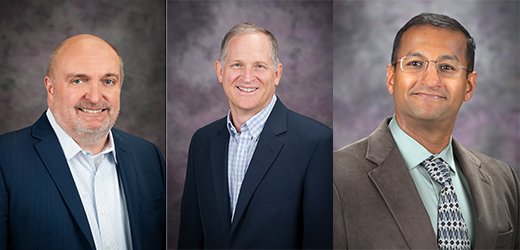Kansas State University cancer research team receives $2 million from NSF
Tuesday, Oct. 29, 2019

From left, Stefan Bossmann, university distinguished professor of chemistry; Chris Culbertson, professor of chemistry; and Bala Natarajan, professor of electrical and computer engineering, have received a $2 million National Science Foundation Emerging Frontiers in Research and Innovation grant. They will collaborate with researchers at the University of Texas Medical Branch on new cancer treatments.
MANHATTAN — Kansas State University researchers, in collaboration with researchers at the University of Texas Medical Branch, have received $2 million in funding from the National Science Foundation Emerging Frontiers in Research and Innovation program to conduct fundamental studies on new treatments for glioblastoma and other cancers.
Led by Stefan Bossmann, university distinguished professor of chemistry, the group includes co-principal investigators Christopher Culbertson, professor of chemistry and associate dean for research in the College of Arts and Sciences, and Bala Natarajan, professor of electrical and computer engineering in the Carl R. Ice College of Engineering, all from Kansas State University.
The most common and most aggressive form of an adult primary brain tumor, glioblastoma is characterized by a poor prognosis, with patients often surviving for less than 16 months despite surgical, radiation and/or chemotherapeutic treatments. Bossmann said that work on this project is motivated by the awareness that the interaction of tumors with their surroundings, together with metabolic factors, is responsible for altering gene expression patterns, which enable the tumor to adapt and escape treatment.
The researchers seek to develop novel biophotonic methods to recognize genomewide epigenetic mutations in glioblastoma. Bossmann said this methodology will not only permit the early diagnosis of the disease, but will also lead to the identification of both mechanic and metabolic stimuli that lead to cell death in glioblastoma and other solid tumors, and thus can be implemented in new treatments.
The work will have implications that reach far beyond glioblastoma and will apply to virtually all diseases with epigenetic drivers, among them other cancers, neurodegenerative and cardiovascular diseases, obesity and metabolic syndrome, Bossmann said.
The researchers plan to develop new microfluidic methods for mechanical and metabolic stimulation of cells and a new model to predict the forms of these stimuli that will trigger cell death.
In collaboration with researchers at the University of Texas Medical Branch, the researchers also will map the response to metabolic and mechanical stimuli. The work will have implications that reach far beyond glioblastoma and will apply to virtually all diseases with epigenetic drivers, among them other cancers, neurodegenerative and cardiovascular diseases, obesity and metabolic syndrome, Bossmann said.
"It is difficult for one researcher to have all of the expertise necessary to make rapid progress on such a difficult problem, so we are excited to have recruited an interdisciplinary team from multiple institutions with the broad breadth of expertise to tackle this terrible disease," Culbertson said. "We hope that a better understanding of how the disease develops will lead to not only novel methods for earlier detection but also to effective treatment options as current treatments are for the most part only palliative in nature."
